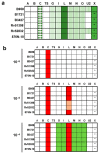Functional and Immunological Studies Revealed a Second Superantigen Toxin in Staphylococcal Enterotoxin C Producing Staphylococcus aureus Strains
- PMID: 36136533
- PMCID: PMC9504012
- DOI: 10.3390/toxins14090595
Functional and Immunological Studies Revealed a Second Superantigen Toxin in Staphylococcal Enterotoxin C Producing Staphylococcus aureus Strains
Abstract
Staphylococcus aureus is a human and animal pathogen as well as a commensal bacterium. It can be a causative agent of severe, life-threatening infections with high mortality, e.g., toxic shock syndrome, septic shock, and multi-organ failure. S. aureus strains secrete a number of toxins. Exotoxins/enterotoxins are considered important in the pathogenesis of the above-mentioned conditions. Exotoxins, e.g., superantigen toxins, cause uncontrolled and polyclonal T cell activation and unregulated activation of inflammatory cytokines. Here we show the importance of genomic analysis of infectious strains in order to identify disease-causing exotoxins. Further, we show through functional analysis of superantigenic properties of staphylococcal exotoxins that even very small amounts of a putative superantigenic contaminant can have a significant mitogenic effect. The results show expression and production of two distinct staphylococcal exotoxins, SEC and SEL, in several strains from clinical isolates. Antibodies against both toxins are required to neutralise the superantigenic activity of staphylococcal supernatants and purified staphylococcal toxins.
Keywords: Staphylococcus aureus; mitogenesis; neutralisation; staphylococcal enterotoxins.
Conflict of interest statement
The authors declare no conflict of interest.
Figures





References
Publication types
MeSH terms
Substances
LinkOut - more resources
Full Text Sources
Other Literature Sources
Medical

